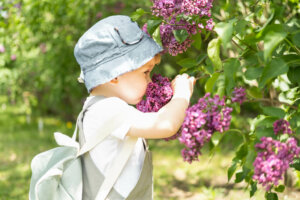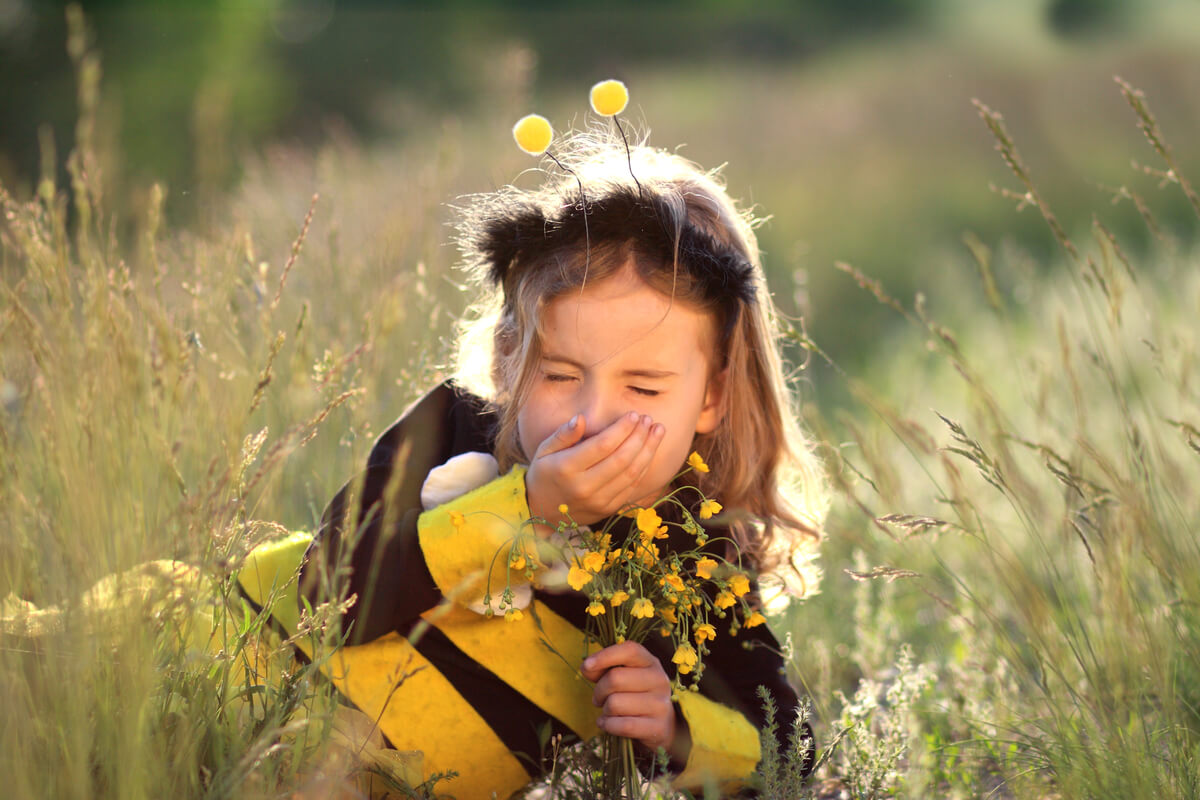Seasonal Allergies in Children

Thousands of cases of seasonal allergies in children are reported each year. Although, of course, these can also develop in adults, the peculiarities of their immune system and the first exposures make this group more susceptible to reactions. Parents should be aware of them, as they can cause moderate or severe complications.
Fortunately, there are many treatment options, as well as small changes during allergy season that reduce the risks. Today, we’ll teach you everything you should know about seasonal allergies in children and young people so that you can take precautions when the time comes.
The characteristics of seasonal allergies in children

According to the Seattle Children’s Hospital, seasonal allergies in children usually begin between the ages of 2 and 5. The reason for this is very simple: During this age range, their interaction with the outdoors is greater, and many even begin their school stage.
Remember at this point that allergies of this type are triggered by external allergens. In particular, pollen’s the allergen responsible for seasonal reactions. Children may have already developed allergies at home but, most likely, they correspond to another type (for example, allergies to pet dander, food, or mites).
Seasonal allergies are also known as hay fever or seasonal allergic rhinitis. However, not all episodes of this type can be classified in this way. Triggers are active at specific times of the year, hence the term seasonal. According to the American Academy of Pediatrics (AAP), these are the main symptoms of seasonal allergy in children:
- Nasal congestion
- Sneezing
- Watery eyes
- Itchy mucous membranes
- A runny nose
- Episodes of inflammation (mainly in moderate or severe cases)
Sometimes, it can be accompanied by signs of asthma. For example, wheezing, shortness of breath, and chest pain. In fact, and as the evidence indicates, most asthmatic children are also sensitive to allergic episodes. Some patients develop flare-up skin reactions during exposure.
Causes of seasonal allergies in children
We’ve already pointed out that pollen is the leading cause of seasonal allergies in children. The American College of Allergy, Asthma & Immunology points out that two major seasons can be distinguished during the year:
- Spring-summer: At this time, the main trees begin their pollination cycle. It starts in early February and runs until about mid-August. The grass, for its part, begins its cycle right in the middle of the season, so this is the reason why more cases are reported during both seasons.
- Autumn: during autumn, apart from other plant species, ragweed is the main culprit for seasonal allergies in children. Technically it begins its cycle in late summer, but its peak is reached in early fall. These episodes have their own name: ragweed allergy.
Researchers agree that the signs are milder during the first exposures to allergens and then increase over the years. Many people believe that only herbs or flowering plants can cause seasonal allergies, but as we’ve noted, trees also release pollen. The Pediatric Associates of Franklin highlights the following:
- Poplars
- Pine trees
- Ash tree
- Elms
- Willows
- Alder
Those produced by these and other plants can travel hundreds of miles on a windy day, so you don’t have to be somewhere surrounded by nature to develop a reaction. In tropical countries, in the absence of seasons, the same proportion of allergens can generally be found throughout the year.
Tips on how to avoid seasonal allergies in children

If you discover that your child develops allergic reactions during specific times of the year, you should take them to a specialist for diagnosis. An allergist will prescribe a treatment to counteract the symptoms once they appear, and will also provide a series of tips to reduce the chances of reactions appearing.
From the hand of Harvard Health Publishing and Children’s Hospital Philadelphia, we’ve compiled the most important recommendations:
- Close your windows during allergy times.
- Turn on the air conditioner to encourage air circulation.
- Encourage hand washing right after you get home. It’s also wise to change clothes (pollen can stick to clothes outside).
- Be thoughtful when choosing hours of recreation outside the home (especially if there’s a heavy wind, it’s midday, or there’s a forecast of high pollen counts).
- Dry your clothes in the washing machine and hang them indoors.
- If the child is going through an allergic reaction, in addition to following the treatment, bathe them so that the pollen adhering to their body is eliminated.
- In case the child has to attend school during this season, encourage the use of the mask to reduce the chances of a reaction.
Applying these tips won’t prevent an allergy episode 100%, but it will reduce the odds considerably. It’s very important that you know what type of allergen is causing the reaction so that you can take specific measures to avoid it.
For this, the specialist will carry out several exposure tests in which the culprit will be determined exactly. If other triggers are discovered (dust, smoke, mites, or some foods), include habits to reduce exposure.
Studies in this regard indicate that the remission of allergies in children is very high as long as they’re under treatment and supervision of a medical professional. Therefore, don’t neglect visits with the specialist as they can make a big difference in the future prognosis of the condition.
Thousands of cases of seasonal allergies in children are reported each year. Although, of course, these can also develop in adults, the peculiarities of their immune system and the first exposures make this group more susceptible to reactions. Parents should be aware of them, as they can cause moderate or severe complications.
Fortunately, there are many treatment options, as well as small changes during allergy season that reduce the risks. Today, we’ll teach you everything you should know about seasonal allergies in children and young people so that you can take precautions when the time comes.
The characteristics of seasonal allergies in children

According to the Seattle Children’s Hospital, seasonal allergies in children usually begin between the ages of 2 and 5. The reason for this is very simple: During this age range, their interaction with the outdoors is greater, and many even begin their school stage.
Remember at this point that allergies of this type are triggered by external allergens. In particular, pollen’s the allergen responsible for seasonal reactions. Children may have already developed allergies at home but, most likely, they correspond to another type (for example, allergies to pet dander, food, or mites).
Seasonal allergies are also known as hay fever or seasonal allergic rhinitis. However, not all episodes of this type can be classified in this way. Triggers are active at specific times of the year, hence the term seasonal. According to the American Academy of Pediatrics (AAP), these are the main symptoms of seasonal allergy in children:
- Nasal congestion
- Sneezing
- Watery eyes
- Itchy mucous membranes
- A runny nose
- Episodes of inflammation (mainly in moderate or severe cases)
Sometimes, it can be accompanied by signs of asthma. For example, wheezing, shortness of breath, and chest pain. In fact, and as the evidence indicates, most asthmatic children are also sensitive to allergic episodes. Some patients develop flare-up skin reactions during exposure.
Causes of seasonal allergies in children
We’ve already pointed out that pollen is the leading cause of seasonal allergies in children. The American College of Allergy, Asthma & Immunology points out that two major seasons can be distinguished during the year:
- Spring-summer: At this time, the main trees begin their pollination cycle. It starts in early February and runs until about mid-August. The grass, for its part, begins its cycle right in the middle of the season, so this is the reason why more cases are reported during both seasons.
- Autumn: during autumn, apart from other plant species, ragweed is the main culprit for seasonal allergies in children. Technically it begins its cycle in late summer, but its peak is reached in early fall. These episodes have their own name: ragweed allergy.
Researchers agree that the signs are milder during the first exposures to allergens and then increase over the years. Many people believe that only herbs or flowering plants can cause seasonal allergies, but as we’ve noted, trees also release pollen. The Pediatric Associates of Franklin highlights the following:
- Poplars
- Pine trees
- Ash tree
- Elms
- Willows
- Alder
Those produced by these and other plants can travel hundreds of miles on a windy day, so you don’t have to be somewhere surrounded by nature to develop a reaction. In tropical countries, in the absence of seasons, the same proportion of allergens can generally be found throughout the year.
Tips on how to avoid seasonal allergies in children

If you discover that your child develops allergic reactions during specific times of the year, you should take them to a specialist for diagnosis. An allergist will prescribe a treatment to counteract the symptoms once they appear, and will also provide a series of tips to reduce the chances of reactions appearing.
From the hand of Harvard Health Publishing and Children’s Hospital Philadelphia, we’ve compiled the most important recommendations:
- Close your windows during allergy times.
- Turn on the air conditioner to encourage air circulation.
- Encourage hand washing right after you get home. It’s also wise to change clothes (pollen can stick to clothes outside).
- Be thoughtful when choosing hours of recreation outside the home (especially if there’s a heavy wind, it’s midday, or there’s a forecast of high pollen counts).
- Dry your clothes in the washing machine and hang them indoors.
- If the child is going through an allergic reaction, in addition to following the treatment, bathe them so that the pollen adhering to their body is eliminated.
- In case the child has to attend school during this season, encourage the use of the mask to reduce the chances of a reaction.
Applying these tips won’t prevent an allergy episode 100%, but it will reduce the odds considerably. It’s very important that you know what type of allergen is causing the reaction so that you can take specific measures to avoid it.
For this, the specialist will carry out several exposure tests in which the culprit will be determined exactly. If other triggers are discovered (dust, smoke, mites, or some foods), include habits to reduce exposure.
Studies in this regard indicate that the remission of allergies in children is very high as long as they’re under treatment and supervision of a medical professional. Therefore, don’t neglect visits with the specialist as they can make a big difference in the future prognosis of the condition.
- Kulig M, Klettke U, Wahn V, Forster J, Bauer CP, Wahn U. Development of seasonal allergic rhinitis during the first 7 years of life. J Allergy Clin Immunol. 2000 Nov;106(5):832-9.
- Ogershok PR, Warner DJ, Hogan MB, Wilson NW. Prevalence of pollen sensitization in younger children who have asthma. Allergy Asthma Proc. 2007 Nov-Dec;28(6):654-8.
- Zhang H, Kaushal A, Soto-Ramírez N, Ziyab AH, Ewart S, Holloway JW, Karmaus W, Arshad H. Acquisition, remission, and persistence of eczema, asthma, and rhinitis in children. Clin Exp Allergy. 2018 May;48(5):568-576.
Este texto se ofrece únicamente con propósitos informativos y no reemplaza la consulta con un profesional. Ante dudas, consulta a tu especialista.







